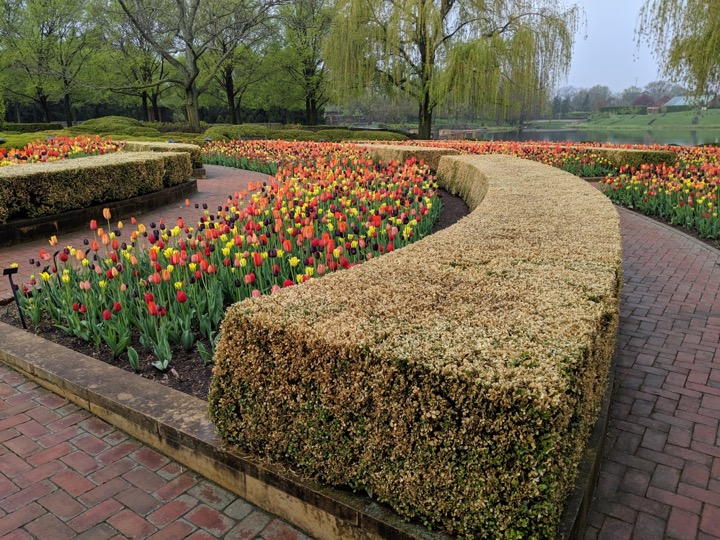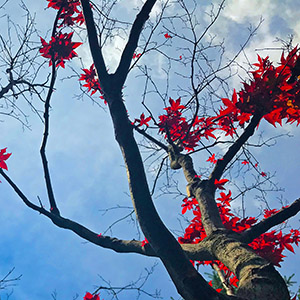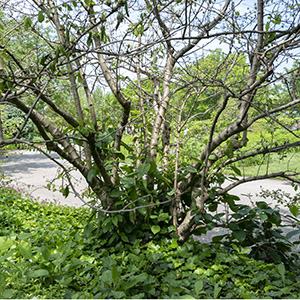The polar vortex and a very wet, cold spring delivered a knockout punch to some plants this year. (You may recall that the Garden was closed for two consecutive days in late January due to extreme weather conditions.) Japanese maples and boxwood were hard hit across northeastern Illinois. Two sycamore trees in the Sensory Garden developed dramatic frost cracks.
In the Crescent Garden, the boxwoods that gave shape to the curving beds all died this winter and were replaced with more annuals. “Certain varieties of boxwood were just killed,” said Tom Tiddens, supervisor of the Garden’s Plant Health Care department. “Other plants—viburnum and forsythia—were killed to the 1-foot line. That’s how deep the snow was.”

In spite of the terrible winter, with temperatures on some days that were more than 50 degrees Fahrenheit below freezing, the 12-inch blanket of snow was a good thing. In the Elizabeth Hubert Malott Japanese Garden, the azaleas are green, but as Tiddens notes, “The flowers only opened on the bottom 1 foot of the plants. It was much more devastating than we thought.”
Tiddens is anticipating a lot of disease this year because of the peculiar conditions. “We’ve had botrytis on tulips that were planted last fall—it’s from the very wet winter. And in May, all the leaves on daylilies looked yellow.”
“A lot of stresses are cumulative, and the past couple of years have been stressful for plants,” Tiddens said. “We’ve had a very cold winter and a slow, wet spring. Plants have a budget—it’s usually more of a balanced budget for resources or growth. When they’re stressed out, the budget goes to defense.”


That cumulative stress goes back several years with a drought in 2012, flooding in 2013, a polar vortex in 2014, several wet springs followed by dry summers, and extreme flooding across northern Illinois in 2017. And it’s not just affecting gardeners. Most Illinois farmers are behind in getting corn and soybeans into the ground this year as a result of persistent rains and cool temperatures.
How plants adapt
In fall, plants typically have plenty of time to acclimate because cooler weather comes slowly. Springtime temperatures, however, can fluctuate wildly, hitting temperatures in the 70s one day and dipping to freezing the next. Many plants do not have adequate time to adjust. Plants that are fooled by mild spring weather may break winter dormancy and start moving water into to their buds. A late spring frost can cause damage to de-acclimated woody stems, blossoms, and new shoots. The new growth may appear water-soaked and may wither within a short time. “Everyone thinks global warming means warmer winters, but the temperatures are up and down,” Tiddens said.
What’s a gardener to do?
Provide the best conditions and cultural practices possible. When buying new plants, match the plant to the site. If you have a spot in sun with heavy clay soil, a shade-loving plant like a hosta will suffer. A plant that is well adapted to your site will perform better and have fewer problems. During the growing season, add supplemental water if there’s no rain. And realize that plants that are not truly hardy to our planting zone will be the first ones damaged by extreme weather conditions.
Thinking ahead
In fall, prepare newly planted trees by wrapping the trunks to protect them from sunscald or frost cracking—vertical cracks in tree trunks that are caused by alternating freezing and thawing temperatures. A layer of mulch on garden beds—placed after the ground freezes but before the snow hits—keeps perennials protected from freeze-and-thaw cycles. The mulch layer insulates the roots from extreme temperatures in case snow is scarce. Also, provide extra winter protection for your plants.
Written by Nina Koziol, garden writer and horticulturist who lives and gardens in Palos Park, Illinois.

